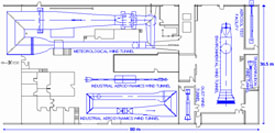Fluid Mechanics and Fluid Dynamics

Program Coordinator:
Karan Venayagamoorthy
karan.venayagamoorthy
970-491-1915
The area of Wind Engineering deals with wind and its effects on human activities, built infrastructure (buildings, structures, etc.) and natural environment. Significant contributions to this field were made through fundamental and applied research carried out by faculty, students and technical personnel at the Wind Engineering and Fluids Laboratory (formerly the Fluid Dynamics and Diffusion Laboratory) at Colorado State University, described herein and on the laboratory website, at www.windlab.colostate.edu. The above activities led to establishment of the Wind Engineering and Fluid Mechanics Program, a program focused on coordinated graduate research and education in wind engineering and fluid mechanics.
Graduate studies in Fluid Mechanics and Fluid Dynamics typically consider the following issues:
- Characterization of wind and fluid mechanics phenomena for engineering applications (effects of earth rotation, friction, wind characteristics and surface shear layer turbulence, extreme winds, wind modeling).
- Wind effects on structures (local and global wind loading, wind-induced response, response control, modeling of wind effects, implementation of codes and standards, risk analysis).
- Atmospheric transport (atmospheric advection and dispersion of pollutants, wind-induced mass transport, control of wind transport of sand and snow, wind effects on agricultural crops and related activities, modeling of atmospheric transport).
- Modification of wind by natural and built environment.
- Wind power and wind effects on traditional and innovative/renewable energy systems.
- Socio-economical effects of wind and wind damage mitigation.